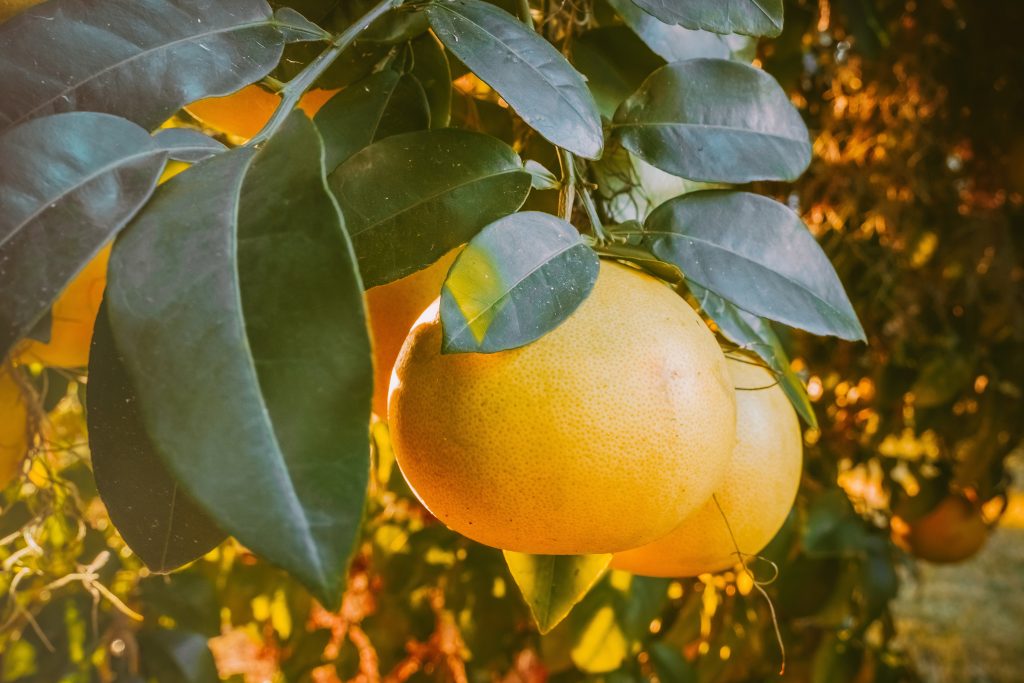Grapefruit is a citrus fruit known for its distinctive ruby color and tangy taste. It is a hybrid of pomelo and orange and is believed to have originated in Barbados in the 18th century.
Table of Contents
What is a Grapefruit?
Grapefruit is a citrus fruit known for its sour, slightly bitter taste and juicy pulp. It is a citrus fruit belonging to the Rutaceae family, including oranges, lemons, and limes. The scientific name for grapefruit is Citrus paradisi.
Grapefruits are known by other names such as pomelo, shaddock, and forbidden fruit. The term “grapefruit” comes from how the fruit grows in clusters on the tree, similar to grapes.
Grapefruits are typically round or slightly oblong and can range in color from pink to red or yellow. The fruit’s skin is thick and tough, and the inside is divided into juicy, sour pulp segments. Some varieties of grapefruit have seeds, while others are seedless.
In terms of flavor, grapefruits are known for their sour and slightly bitter taste. The flavor can vary depending on the variety, with some grapefruits being sweeter than others. Some people enjoy eating grapefruit on its own, while others prefer adding sugar or honey to balance out the tartness.
This lovely fruit can also have numerous health benefits and promote heart health. Still, it might interact with other medications, so discuss it with a healthcare provider before adding it as a supplement to your diet.

The History of Grapefruit
Grapefruit is a citrus fruit believed to have originated in Barbados in the Caribbean. The fruit is thought to be a hybrid of two other citrus fruits, the pomelo and the sweet orange, and was first documented in 1750 by a Welshman named Rev. Griffith Hughes, who described the fruit growing in Barbados as the “forbidden fruit.”
In the early 1800s, the grapefruit was brought to Florida by a French count named Odet Philippe, who is credited with introducing the fruit to the United States. However, it was in the late 19th century that the fruit became popular in America.
Seventy years after Odet Philippe planted it, Kimball Chase Atwood began growing and promoting grapefruit in Texas. Atwood saw the potential of the fruit and began to market it as a health food, touting its high vitamin C content and ability to aid digestion. His plantation became the world’s leading producer of grapefruit.
The popularity of grapefruit continued to grow throughout the 20th century, with new varieties being developed and marketed. Today, grapefruit is grown in many parts of the world, including the United States, Mexico, Israel, and South Africa, and is enjoyed both as a breakfast fruit and as an ingredient in many culinary dishes.
What Does a Grapefruit Taste Like?
Grapefruit is a citrus fruit typically eaten raw, with a distinct, tangy flavor that can be pretty sour. It is often described as having a bitter, slightly sweet taste with a refreshing, tart aftertaste.
When cooked, its flavor can become milder and less sour. For example, broiling a grapefruit with a sprinkle of brown sugar can bring out its natural sweetness while retaining some of its tartness.
How to Tell When Grapefruit is Ripe
When a grapefruit becomes ripe, there are several visual characteristics you can look for to determine its readiness. Here are some signs of a ripe grapefruit:
| Texture | A ripe grapefruit should feel slightly soft when gently squeezed. However, it should not feel mushy or overly squishy. |
| Firmness | A ripe fresh fruit should not be rock hard but gives slightly when pressed with the fingers. |
| Scent | A ripe grapefruit will have a sweet, fragrant aroma that is noticeable when you hold it close to your nose. |
| Smoothness/Roughness | A ripe grapefruit should be smooth and firm without any soft spots or bruising. Avoid grapefruits with rough or uneven skin, as they may not be ripe. |
| Color | The color of a grapefruit can vary depending on the variety, but a ripe grapefruit should be yellow or pink with a slightly red or orange blush. Avoid green or pale-colored grapefruits as they are likely underripe. |
Note: It’s also important to consider the variety of grapefruit you purchase, as different types have different flavors and levels of sweetness. For example, pink grapefruits are sweeter than white grapefruits, while red grapefruits have a more intense flavor.
Cooking with Grapefruit
To prepare grapefruit:
- Start by cutting off the ends of the fruit.
- Use a sharp knife to cut off the peel and pith in sections, following the curve of the fruit.
- Once the peel and pith are removed, cut the fruit into sections by slicing along the membranes that separate each section. This will give you easy-to-eat grapefruit pieces.
When it comes to cooking with grapefruit, it is most commonly used in salads, desserts, and beverages. It can also be used as a flavoring agent in savory dishes. Grapefruit is frequently found in cuisines that use tropical fruits, such as Caribbean, Mexican, and Southeast Asian cuisine.

Here are a few specific dishes that feature grapefruit:
Broiled Grapefruit with Honey and Bananas: This recipe uses honey and bananas to sweeten broiled grapefruits. The honey also helps caramelize the grapefruit, which makes it taste like a sweet, juicy steak. It’s also an excellent way to get your kids to eat fruit when they’re not in the mood.
Beet and Grapefruit Salad: This dish is a good balance of sweet and savory, but it also has a lot of different textures, which is always fun. The beets add a nice sweetness to the grapefruit, and the blue cheese and walnuts balance it.
Ginger Grapefruit Salmon: Try this recipe for an Asian-inspired salmon dish that will impress your guests at dinner parties! The flavors meld perfectly together.
Candied Grapefruit Peel: The candied grapefruit peel adds just enough sweetness that you won’t feel guilty eating something rich in vitamin C and fiber. It’s excellent as an appetizer or dessert!
How to Store Grapefruit
If the grapefruit is unripe, storing it at room temperature until it ripens is best. Once it matures, it can be stored on the counter for up to one week.
If you prefer your grapefruit chilled, store it in the fridge. This will also help extend its shelf life. Place the grapefruit in the fruit drawer or a plastic bag in the refrigerator for up to two weeks.
To freeze, cut the grapefruit into segments, remove the seeds, and place the segments in a freezer-safe container or bag. You can now use them in smoothies (with other fruits or veggies) and ice cream. You can freeze grapefruit for up to six months.
Lastly, grapefruit can also be dried. Cut the grapefruit into thin slices and place them in a dehydrator or oven at a low temperature. Keep for up to six months.

Nutritional Benefits of Grapefruit
Despite being mostly made up of water, grapefruit is a fruit that can promote a healthy diet, as it is full of many vitamins, minerals, and nutrients. Grapefruit is good for you because it has a lot of dietary fiber, which helps digestion and reduces inflammation.
Grapefruit is also a high source of vitamin C, a powerful antioxidant that boosts the immune system, fights off harmful bacteria and viruses, and protects against disease. Additionally, grapefruit contains high levels of vitamin A, or beta carotene, essential for maintaining eye health, supporting the immune system, and fighting inflammation.
In addition to these nutrients, grapefruit is a good source of potassium, magnesium, thiamine, and folate. It also contains lycopene, an antioxidant that reduces cellular damage and may help prevent serious illnesses like cancer and heart disease. It can also aid in lowering the risk of type 2 diabetes.
Despite the numerous health benefits of grapefruit, grapefruit juice has a dark side, as it can interact with other medications in two ways:
- By raising blood levels and increasing the likelihood of side effects (this happens because it can block a key drug-metabolizing enzyme – CYP3A4)
- By decreasing the drug’s effectiveness (blocking its absorption in the intestines).
Some of the medication interactions include the anti-anxiety drug alprazolam (Xanax and generic), the allergy medication fexofenadine (Allegra), certain statins (medication to lower cholesterol), the high blood pressure medication nifedipine (Afeditab, Procardia, and generic), the cholesterol-lowering drugs Zocor (simvastatin) or Lipitor (atorvastatin).
The Other Uses of Grapefruit
| Soap | Grapefruit essential oil is used in soaps due to its natural antiseptic properties. It can help cleanse the skin and remove impurities, leaving it fresh and rejuvenated. |
| Air Freshener | Grapefruit oil can be used as a natural air freshener. Its refreshing scent helps neutralize odors and create a clean, uplifting atmosphere in your home or office. Simply add a few drops of grapefruit oil to a diffuser or spray bottle filled with water and spray in the air. |
| Animal Repellent | Grapefruit oil is also an effective animal repellent. Its strong scent helps keep pests such as rodents and insects away. To use grapefruit oil as an animal repellent, add a few drops to cotton balls and place them where pests are likely present. |
| Skincare | Grapefruit contains antioxidants that can help protect the skin from damage caused by free radicals. It is often used in skincare products such as facial cleansers and tinere, but they’re incredibly popular in scrubs. |
| Weight Loss | Grapefruit is believed to aid in weight loss due to its low-calorie and high-fiber content. It can also help regulate blood sugar levels and improve metabolism. |
Where to Purchase Grapefruit
If you’re looking for fresh grapefruit, you can typically find them in the produce section of your local grocery store or supermarket. Specialty stores, such as health food stores and gourmet markets, may also carry grapefruit, often in a broader range of varieties and flavors than what is available at regular grocery stores. These stores may also offer organic or locally grown grapefruits.
If you live in an area with a mild climate, you may find locally grown grapefruit at your farmers’ market during the peak season.

